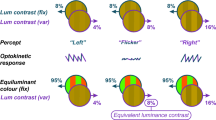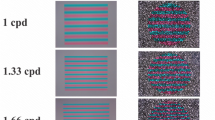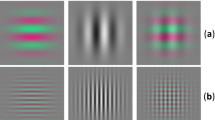Abstract
Patients with cerebral achromatopsia, resulting from damage to ventromedial occipital cortex, cannot chromatically order, or discriminate, hue. Nevertheless, their chromatic contrast sensitivity can be indistinguishable from that of normal observers. A possible contributor to the detectability of chromatic gratings is the subadditive nature of certain colour combination such that mixtures of, for example, red and green (yielding yellow) appear dimmer than expected from the simple addition of luminances. This subadditivity is believed to reflect colour-opponent interactions between the outputs of long- and medium-wavelength cones. We performed a first-order compensation for such subadditivity in chromatic gratings and demonstrated that their detection was still not abolished in an achromatopsic patient. In addition, we used a two-alternative forced-choice procedure with an achromatopsic patient, who was required to judge the apparent relative velocity of two drifting gratings with different degrees of compensation for subadditivity. It is well known that isoluminant gratings, constructed by adding a red and green sinusoidal grating of identical peak luminances in antiphase, appear to drift substantially slower than an achromatic grating with the same velocity. Adding 2f luminance compensation to an isoluminant grating of spatial frequency f, resulted in an identical minimum of perceived velocity at a compensation contrast of 5% in both achromatopsics and normal observers. Furthermore, while compensation for subadditivity did not substantially compromise grating detection at low contrasts, such correction severely affected motion detection. Saccadic eye movement accuracy and latency were also measured to uncompensated chromatic, compensated chromatic and achromatic targets. We conclude first that subadditivity, resulting from colour-opponent P-channel processes, influences motion judgements. The ability to extract motion from chromatic differences alone is little, if at all, different in achromatopsic and normal vision. Second, the paradoxical detection of sinusoidally modulated chromatic gratings in achromatopsic patients is not merely a result of subadditivity. Third, saccadic latency, but not accuracy, to chromatic targets is affected by luminance compensation. Finally, and more generally, wavelength processing continues to contribute to several aspects of visual processing even when colour is not perceived.
Similar content being viewed by others
Author information
Authors and Affiliations
Rights and permissions
About this article
Cite this article
Heywood, C., Kentridge, R. & Cowey, A. Form and motion from colour in cerebral achromatopsia. Exp Brain Res 123, 145–153 (1998). https://doi.org/10.1007/s002210050555
Issue Date:
DOI: https://doi.org/10.1007/s002210050555




